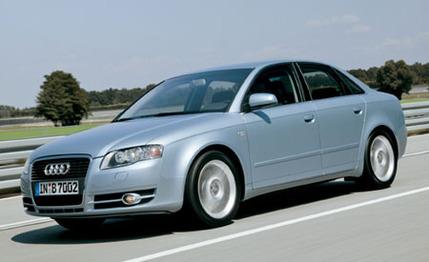
 First Drive Review
First Drive Review
The Targa Florio was a crazy, dangerous sports-car race held on tortuous public roads in the Madonie Mountains of Sicily between 1906 and 1973, producing big heroes and equally big crashes. Now, only one of three variations of the course survives in any complete sense, and that's the narrow, bumpy, twisting 44-mile Piccolo Madonie, which connects the towns of Collesano, Campofelice, Cerda, and Caltavuturo. It's still used for the current-day commemorative Targa Florio Storica event.
Sounds like a good place to try out a range of expensive new Audi A4s and S4s, right? Perhaps with the old pits as the center of Audi's ride-and-drive operations? We thought so, too.
This new A4 is the result of a redesign that, from the look of it, got somewhat carried away, resulting in interesting technical upgrades as well as the controversial face and butt lifts you see here. Most important of the mechanical revisions was the adoption of Audi's direct-injection FSI 2.0-liter turbocharged inline four and FSI 3.1-liter V-6 to replace the current 1.8T and 3.0-liter V-6 powerplants we're familiar with in the States.
"FSI" (fuel stratified injection) denotes that these engines use direct fuel injection. The more familiar port injection puts fuel into the intake passages; direct injection squirts gas right into the combustion chamber. There are a few benefits of FSI, but for the A4 we'll get here, Audi has so far exploited just one: better charge cooling and reduced hot spots in the chamber. With less risk of detonation, Audi raised the compression ratio to increase engine efficiency. The 2.0-liter turbo has a 10.5:1 compression ratio versus 9.3:1 for the outgoing 1.8T.
Although FSI does allow engines to run lean air-to-fuel ratios-thus saving fuel-there is a side effect of increased production of NOx. There are catalytic converters that can remove the extra NOx, but the high-sulfur fuel we use in the U.S. contaminates them. There are Audi engines in Europe-including racing powerplants-that use FSI with lean burn, but here, FSI engines run about the same air-to-fuel ratio as port-injected engines. So for us, FSI is short for "fuel straight injection."
Benefiting from power gains of about 30 or so horsepower, compared with their predecessors, both new engines are a distinct improvement, with better throttle response and stronger acceleration. The 2.0-liter, in particular, provides much more muscular low- and midrange response, with full-boost urge now so vivid that front-drive models have begun to feel the effects of torque steer-something Audi's clever front-suspension geometries had previously repressed. In Quattro all-wheel-drive models, however, the extra thrust simply hauls the car down the road in a way that makes you question the need for the V-6.
Although the suspension is conceptually similar to that of existing A4s, the company insists it has been completely modified, with several new components added. Spring and shock settings were recalibrated, and the shock mountings and dimensions have been requisitioned directly from the new A6. Rear trapezoidal links (as Audi likes to call them), along with wheel carriers and front tie rods, were borrowed from the brawny V-8-powered S4. Best of all, the new A4s get a Servotronic steering mechanism that varies the level of assistance depending on vehicle speed, lending a much better steering feel than current systems do.
Ironically, that means the high-performance S4 has more carry-over technology than its tamer siblings, with an essentially unchanged 4.2-liter V-8 and a suspension simply retuned for its new role. But bear in mind that the S4 was a more recent development. Of course, this latest S4 now flaunts the new bodywork and glowers through its own "frame grille," and it's still the best model to reel in those 44 miles of winding Piccolo Madonie blacktop.
Not that the other A4s are slow, and the price jump from a 2.0T to the S4 is significant at about 20 grand. So the 2.0T looks like quite a deal as German sports sedans go. And you're certainly not shortchanged on interior quality or standard equipment. The '06 A4s (both 2.0T and 3.1 V-6) get an aluminum-trimmed interior with dual climate control, a Symphony radio with an in-dash six-CD changer, and a North America-only center console with twin cup holders and an extra power socket.
The V-6 model gets standard leather seats and power front seats. On the four-cylinder car, these are part of the Premium package. An optional audio package includes a Bose premium sound system and prewiring for satellite radio.
Among the stand-alone options are xenon headlights that pivot up to 15 degrees to illuminate curves, a sport-suspension package with new 17-inch split-spoke wheels, and a DVD navigation system. Rear side airbags, Bluetooth phone prep, and tire-pressure monitoring are also available.
In addition, Audi is introducing the S-line-a model level providing 18-inch wheels, a sport suspension, a perforated-leather steering-wheel cover, and interior and exterior trim and badging-in the fall of 2005.
Maybe you'll take an instant liking to the new Audi face with its deep trapezoidal grille, or maybe not, but it's hard to deny the look is distinctive. The A4 is arguably the best-looking of the new Audis, and we have to applaud the fact that the rear styling now varies considerably among different models, even if the fronts are now less easy to differentiate. We think the new nose grows on you. Give it time.